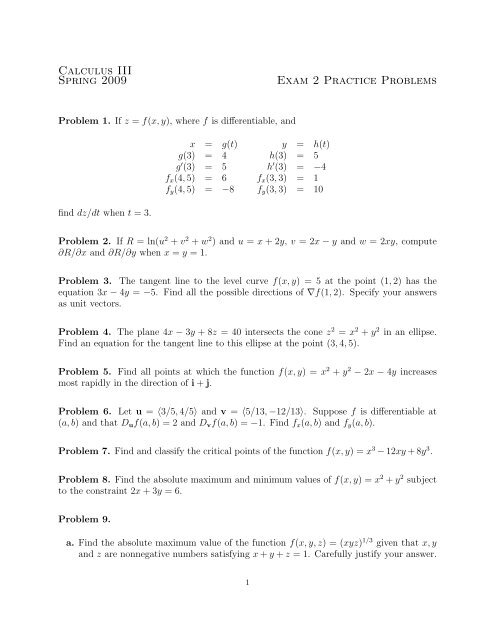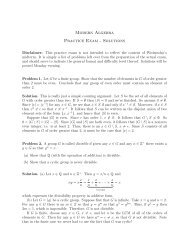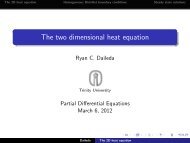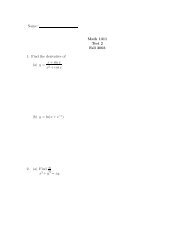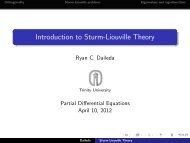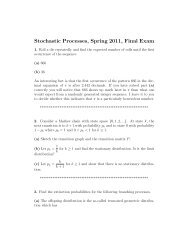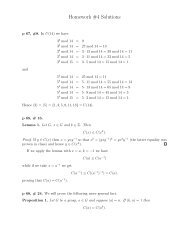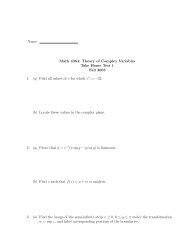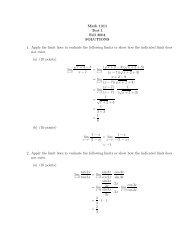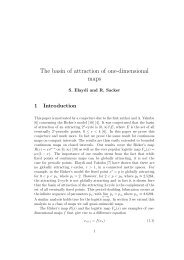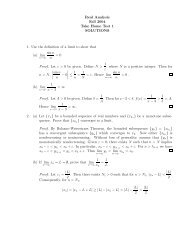Calculus III Spring 2009 Exam 2 Practice Problems
Calculus III Spring 2009 Exam 2 Practice Problems
Calculus III Spring 2009 Exam 2 Practice Problems
You also want an ePaper? Increase the reach of your titles
YUMPU automatically turns print PDFs into web optimized ePapers that Google loves.
<strong>Calculus</strong> <strong>III</strong><br />
<strong>Spring</strong> <strong>2009</strong><br />
<strong>Exam</strong> 2 <strong>Practice</strong> <strong>Problems</strong><br />
Problem 1. If z = f(x, y), where f is differentiable, and<br />
find dz/dt when t = 3.<br />
x = g(t) y = h(t)<br />
g(3) = 4 h(3) = 5<br />
g ′ (3) = 5 h ′ (3) = −4<br />
f x (4, 5) = 6 f x (3, 3) = 1<br />
f y (4, 5) = −8 f y (3, 3) = 10<br />
Problem 2. If R = ln(u 2 + v 2 + w 2 ) and u = x + 2y, v = 2x − y and w = 2xy, compute<br />
∂R/∂x and ∂R/∂y when x = y = 1.<br />
Problem 3. The tangent line to the level curve f(x, y) = 5 at the point (1, 2) has the<br />
equation 3x − 4y = −5. Find all the possible directions of ∇f(1, 2). Specify your answers<br />
as unit vectors.<br />
Problem 4. The plane 4x − 3y + 8z = 40 intersects the cone z 2 = x 2 + y 2 in an ellipse.<br />
Find an equation for the tangent line to this ellipse at the point (3, 4, 5).<br />
Problem 5. Find all points at which the function f(x, y) = x 2 + y 2 − 2x − 4y increases<br />
most rapidly in the direction of i + j.<br />
Problem 6. Let u = 〈3/5, 4/5〉 and v = 〈5/13, −12/13〉. Suppose f is differentiable at<br />
(a, b) and that D u f(a, b) = 2 and D v f(a, b) = −1. Find f x (a, b) and f y (a, b).<br />
Problem 7. Find and classify the critical points of the function f(x, y) = x 3 − 12xy + 8y 3 .<br />
Problem 8. Find the absolute maximum and minimum values of f(x, y) = x 2 + y 2 subject<br />
to the constraint 2x + 3y = 6.<br />
Problem 9.<br />
a. Find the absolute maximum value of the function f(x, y, z) = (xyz) 1/3 given that x, y<br />
and z are nonnegative numbers satisfying x + y + z = 1. Carefully justify your answer.<br />
1
. Use the result of part (a) to deduce the arithmetic-geometric mean inequality: if a, b, c ≥<br />
0 then<br />
3√ a + b + c<br />
abc ≤ .<br />
3<br />
When can equality hold?<br />
Problem 10. Find the absolute maximum and minimum values of f(x, y) = e −xy on the<br />
region {(x, y) | x 2 + 4y 2 ≤ 2}.<br />
Problem 11. Find the volume of the solid that lies under the plane 3x + 2y + z = 12 and<br />
above the rectangle R = [0, 1] × [−2, 3].<br />
2


